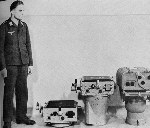The following are excerpts taken from
"Handbook on German Military Forces".
 |
• |
Operational Reconnaissance: |
 |
Operational reconnaissance, penetrating over large area in great depth, provided the basis for strategic planning and action. This was typically carried out by the Luftwaffe using aerial photography. |
Photo shows three types of Luftwaffe cameras
used for aerial photography.
 |
Mission assignments: |
 |
Motorized units if employed for operational reconnaissance were normally assigned only directions and objectives. |
 |
Mission intentions: |
 |
To determine the location and activities of the enemy forces, particularly localities of rail concentrations, forward or rearward displacements of personnel, loading or unloading areas of army elements, the construction of field or permanent fortifications, hostile air force concentrations and the identification of large enemy motorized elements. |
 |
Opinion for game use: |
 |
In WWII Online, Operational Reconnaissance should mostly be done by air units of the Luftwaffe, as ground units will be taxed for the use of petrol. If the German chain of command can not organize this to their satisfaction they can always rely on our squads "Gathered Intelligence" section, which will include screen shots and area information. |
 |
• |
Tactical Reconnaissance: (Taktische Aufklarung) |
 |
Tactical reconnaissance, carried out in the area behind the operational reconnaissance, provided the basis for the commitment of troops. When advancing with a division, the reconnaissance battalion seldom operated more then one days march in front of the division, sending advancing patrols to obtain information needed. |
 |
Mission assignments: |
 |
The direction and radius of employment were based on the results of the operational reconnaissance. As assigned to ground battalions, boundary lines separated adjacent units. The Germans avoided using main roads as boundary lines, defining the sectors in such a way that main roads would fall within the assigned sectors. The width of the sector was determined by the situation, the type and strength of the reconnaissance battalion, the road net and the terrain. In general, the width of the sector assigned to a motorized recon. battalion did not exceed 30 miles. |
 |
Mission Intentions: |
 |
To identify the enemy's organization, disposition, strength, and antiaircraft defense; determination of the enemy's reinforcement capabilities; terrain reconnaissance of advanced sectors. |
 |
The reconnaissance battalion commander would normally send out patrols which advanced in bounds, usually no more then an hours travel ahead of the reconnaissance battalion. The length of the bounds was determined by the area at hand, such as roads and terrain. The bounds decreased as the distance towards the enemy decreased. Different directions of travel were used when advancing and returning. The reconnaissance battalion itself served as reserves for the patrols and as an advanced message center for the main division in the rear. |
 |
Guideline to Orders: |
 |
Orders issued to a reconnaissance battalion normally contained, in addition to the mission, the following: |
 |
1. Line of departure. |
 |
2. Information concerning adjacent recon. units. |
 |
3. Sector boundaries or direction of operations. |
 |
4. objectives. |
 |
5. Phase lines. |
 |
6. Instructions for transmission of reports. |
 |
7. Location of immediate objectives whose attainment is to be reported. |
 |
8. Instructions regard air-ground liaison. |
 |
9. Time of departure, route, and objective of main force. |
 |
Opinion for game use: |
 |
Tactical Recon. will mostly likely be used only by large WWII Online squads that are very organized. Our Panzerspahwagen squad (Aufklarung Abt.) will be playing using this form of recon. We will send information back to whichever units are behind us in the missions we chose to partake in or to the units that have chosen to use us for that night. The "Guideline to Orders" is a good historical listing that can be changed and modified for Online squads, so it will most likely be picked up for use. |
|
|
 |
|
Back
|
 |
Next
|
Click the Toten to go out
|
